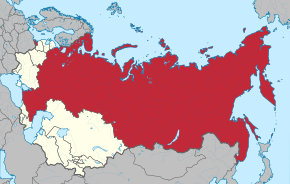Russian Soviet Federative Socialist Republic (1917–1991)
More languages
More actions
| Russian Soviet Federative Socialist Republic Российская Советская Федеративная Социалистическая Республика | |||||||||||
|---|---|---|---|---|---|---|---|---|---|---|---|
| 1917–1991 | |||||||||||
Motto: "Пролетарии всех стран, соединяйтесь!" | |||||||||||
Anthems: "Worker's Marseillaise" (1917-1918) "The Internationale" (1918-1944) "The Patriotic Song" (1990-1991) | |||||||||||
 The RSFSR after being merged with the Karelian SSR in 1956 | |||||||||||
| Capital and largest city | Moscow | ||||||||||
| Official languages | Russian | ||||||||||
| Dominant mode of production | Socialism | ||||||||||
| Government | Marxist-Leninist state | ||||||||||
| History | |||||||||||
• Great October Socialist Revolution | 7 November 1917 | ||||||||||
• Soviet Union established | 30 December 1922 | ||||||||||
• Sovereignty declared | 12 June 1990 | ||||||||||
| 26 December 1991 | |||||||||||
| Population | |||||||||||
• 1991 estimate | 148,273,746[1] | ||||||||||
| |||||||||||
The Russian Soviet Federative Socialist Republic (Russian SFSR or RSFSR),[a][note 1] was an independent socialist state from 1917 to 1922 before it was incorporated into the Union of Soviet Socialist Republics (USSR) in 1922 and eventually becoming the bourgeois Russian Federation in 1991.
Nomenclature
Geography
The Russian SFSR was the geographically largest Socialist republic within the USSR, maintaining a territory which reached from the Black Sea and Baltic Sea in its most western extremity, to the Pacific Ocean in the east.
History
Government
Workers, peasants, and soldiers aged 18 or older could vote in elections to the All-Russian Congress of Soviets, which later became the Supreme Soviet of the RSFSR. Some local soviets had lower voting ages. Capitalists, landlords, clergy, and former members of the Tsarist police could not vote.[2]
All-Russian Congress of Soviets
The All-Russian Congress of Soviets had one delegate for every 25,000 urban workers and one delegate for every 125,000 people in rural areas. It elected the All-Russian Central Executive Committee.[2]
Local soviets
Regional soviets could have up to 500 members and had one delegate per 25,000 rural population or 5,000 urban population. Provincial soviets could have up to 200 members, with one delegate for every 10,000 of the rural population or 2,000 of the urban population. County soviets had one delegate for every 1,000 inhabitants and could have up to 300 delegates. Village soviets had one delegate for every 10 residents.[2]
Culture
References
Notes
- ↑ Russian: Российская Советская Федеративная Социалистическая Республика (РСФСР)
- ↑ It was previously known as the Russian Soviet Republic and the Russian Socialist Federative Soviet Republic as well as being unofficially known as Soviet Russia, the Russian Federation or simply Russia.


